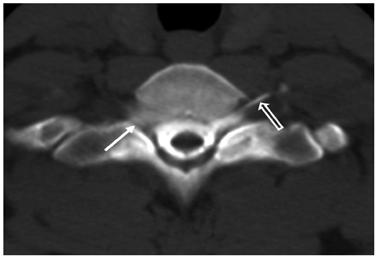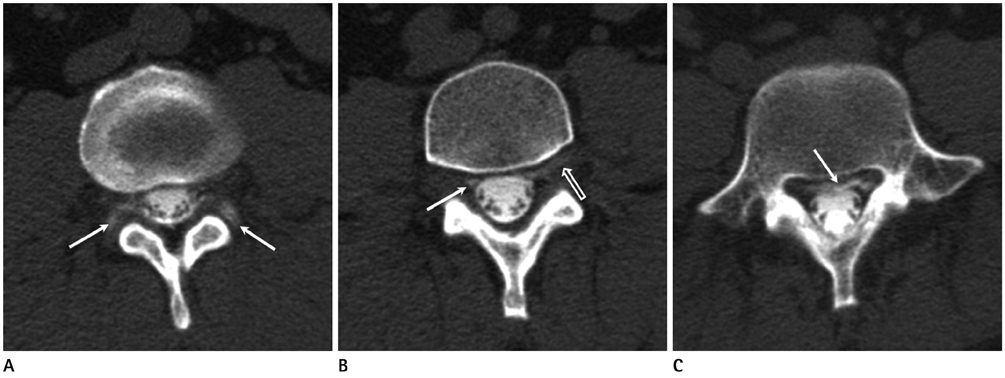J Korean Soc Radiol.
2014 Apr;70(4):299-305. 10.3348/jksr.2014.70.4.299.
Comparison of the Efficacy of Epidural Autologous Blood Patch in the Treatment of Spontaneous Intracranial Hypotension and Post-Dural Puncture Headache
- Affiliations
-
- 1Department of Radiology, Seoul National University Bundang Hospital, Seongnam, Korea. netty0523@gmail.com
- KMID: 2041942
- DOI: http://doi.org/10.3348/jksr.2014.70.4.299
Abstract
- PURPOSE
To evaluate and compare the effectiveness of fluoroscopy-guided epidural blood patch (EBP) in patients with post-dural puncture headache (PDPH) and spontaneous intracranial hypotension (SIH).
MATERIALS AND METHODS
Between August 2012 and September 2013, 16 patients (12 with PDPH, 4 with SIH; 5 males, 11 females; age range 19-58 years, mean age 32.8 years) who underwent EBP in the Department of Radiology were included in this study. Pain relief within three days after EBP was evaluated based on medical record and classified on a 3-level scale: complete relief; incomplete relief; and failure. Recurrence is defined as aggravated postural headache after three days. We evaluated and compared treatment outcome between PDPH and SIH, using Fisher's exact test (considered as significant when p < 0.05).
RESULTS
In 12 PDPH patients, the EBP provided complete relief in 5 patients (41.7%), and incomplete relief in 7 patients (58.3%). In 4 SIH patients, the EBP provided complete relief in 1 patient (25%), and incomplete relief in 3 patients (75%). There was no significant difference (p = 0.511) of pain relief rate between PDPH and SIH. There was recurrence in 5 patients with PDPH and 1 patient with SIH. Five PDPH patients were retreated by EBP with incomplete relief.
CONCLUSION
Fluoroscopy-guided EBP provides effective treatment of postural headache for both SIH and PDPH patients.
MeSH Terms
Figure
Cited by 1 articles
-
The Efficacy of a Fluoroscopy Guided Epidural Autologous Blood Patch In the Treatment of a Post-Dural Puncture Headache
Ji Eun Park, Eugene Lee, Joon Woo Lee, Yusuhn Kang, Joong Mo Ahn, Heung Sik Kang
J Korean Soc Radiol. 2018;78(4):242-248. doi: 10.3348/jksr.2018.78.4.242.
Reference
-
1. Kokki M, Sjövall S, Kokki H. Epidural blood patches are effective for postdural puncture headache in pediatrics--a 10-year experience. Paediatr Anaesth. 2012; 22:1205–1210.2. Kawaguchi M, Hashizume K, Watanabe K, Inoue S, Furuya H. Fluoroscopically guided epidural blood patch in patients with postdural puncture headache after spinal and epidural anesthesia. J Anesth. 2011; 25:450–453.3. van Kooten F, Oedit R, Bakker SL, Dippel DW. Epidural blood patch in post dural puncture headache: a randomised, observer-blind, controlled clinical trial. J Neurol Neurosurg Psychiatry. 2008; 79:553–558.4. Allmendinger AM, Lee TC. Spontaneous intracranial hypotension from calcified thoracic disc protrusions causing CSF leak successfully treated with targeted epidural blood patch. Clin Imaging. 2013; 37:756–761.5. Mokri B. Spontaneous low pressure, low CSF volume headaches: spontaneous CSF leaks. Headache. 2013; 53:1034–1053.6. Watanabe K, Hashizume K, Kawaguchi M, Fujiwara A, Sasaoka N, Furuya H. Fluoroscopically guided epidural blood patch with subsequent spinal CT scans in the treatment of spontaneous cerebrospinal fluid hypovolemia. J Neurosurg. 2011; 114:1731–1735.7. Safa-Tisseront V, Thormann F, Malassiné P, Henry M, Riou B, Coriat P, et al. Effectiveness of epidural blood patch in the management of post-dural puncture headache. Anesthesiology. 2001; 95:334–339.8. Williams EJ, Beaulieu P, Fawcett WJ, Jenkins JG. Efficacy of epidural blood patch in the obstetric population. Int J Obstet Anesth. 1999; 8:105–109.9. Albes G, Weng H, Horvath D, Musahl C, Bäzner H, Henkes H. Detection and treatment of spinal CSF leaks in idiopathic intracranial hypotension. Neuroradiology. 2012; 54:1367–1373.10. Kranz PG, Gray L, Taylor JN. CT-guided epidural blood patching of directly observed or potential leak sites for the targeted treatment of spontaneous intracranial hypotension. AJNR Am J Neuroradiol. 2011; 32:832–838.11. Gormley JB. Current comment: treatment of postspinal headache. Anesthesiology. 1960; 21:565–566.12. Sencakova D, Mokri B, McClelland RL. The efficacy of epidural blood patch in spontaneous CSF leaks. Neurology. 2001; 57:1921–1923.13. Vilming ST, Titus F. Low cerebrospinal fluid pressure. In : Olefson J, Tfelt-Hansen P, Welch KMA, editors. The Headache. New York: Raven Press;1993. p. 687–695.14. Schievink WI. Spontaneous spinal cerebrospinal fluid leaks. Cephalalgia. 2008; 28:1345–1356.15. Buvanendran A, Byrne RW, Kari M, Kroin JS. Occult cervical (C1-2) dural tear causing bilateral recurrent subdural hematomas and repaired with cervical epidural blood patch. J Neurosurg Spine. 2008; 9:483–487.16. Vanopdenbosch LJ, Dedeken P, Casselman JW, Vlaminck SA. MRI with intrathecal gadolinium to detect a CSF leak: a prospective open-label cohort study. J Neurol Neurosurg Psychiatry. 2011; 82:456–458.17. Albayram S, Kilic F, Ozer H, Baghaki S, Kocer N, Islak C. Gadolinium-enhanced MR cisternography to evaluate dural leaks in intracranial hypotension syndrome. AJNR Am J Neuroradiol. 2008; 29:116–121.18. Kapoor R, Liu J, Devasenapathy A, Gordin V. Gadolinium encephalopathy after intrathecal gadolinium injection. Pain Physician. 2010; 13:E321–E326.
- Full Text Links
- Actions
-
Cited
- CITED
-
- Close
- Share
- Similar articles
-
- A Case Report of Spontaneous Intracranial Hypotension Treated with Cervical Epidural Blood Patch
- Three Cases of Spontaneous Intracranial Hypotension ( SIH ) Treated with Epidural Blood Patch
- Epidural Blood Patch for the Treatment of Abducens Nerve Palsy due to Spontaneous Intracranial Hypotension: A Case Report
- Spontaneous Intracranial Hypotension Treated with Epidural Blood Patch: A case report
- Spontaneous Intracranial Hypotension after Post-dural Puncture Headache : A case report



